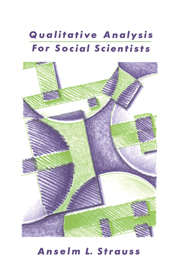Book contents
- Frontmatter
- Contents
- Preface
- 1 Introduction
- 2 Two illustrations
- 3 Codes and coding
- 4 Seminar on open coding
- 5 Memos and memo writing
- 6 Team meetings and graphic representations as memos
- 7 Excerpts that illustrate common problems
- 8 Integrative diagrams and integrative sessions
- 9 Integrative mechanisms: diagrams, memo sequences, writing
- 10 Presenting case materials: data and interpretations
- 11 Grounded formal theory: awareness contexts
- 12 Reading and writing research publications
- 13 Questions and answers
- 14 Research consultations and teaching: guidelines, strategies, and style
- Epilogue
- Appendix Discovering new theory from previous theory
- References
- Author index
- Subject index
2 - Two illustrations
Published online by Cambridge University Press: 26 January 2010
- Frontmatter
- Contents
- Preface
- 1 Introduction
- 2 Two illustrations
- 3 Codes and coding
- 4 Seminar on open coding
- 5 Memos and memo writing
- 6 Team meetings and graphic representations as memos
- 7 Excerpts that illustrate common problems
- 8 Integrative diagrams and integrative sessions
- 9 Integrative mechanisms: diagrams, memo sequences, writing
- 10 Presenting case materials: data and interpretations
- 11 Grounded formal theory: awareness contexts
- 12 Reading and writing research publications
- 13 Questions and answers
- 14 Research consultations and teaching: guidelines, strategies, and style
- Epilogue
- Appendix Discovering new theory from previous theory
- References
- Author index
- Subject index
Summary
After that long introductory discussion, a “methods” book would ordinarily move directly to presenting in concrete detail the initial steps of research procedure – in this instance, the coding of data. We shall not do that yet. Readers who are eager to get quickly to the procedures can skip the present chapter, returning to it later. But it is placed here for those readers who need some overall visualization of the spate of terms discussed rather abstractly in the preceding pages.
There are two reasons for placing the material given below at this precise point in the book. The first is to give some sense of how a grounded theorist operates with data, since that style of analysis is somewhat different than other modes. Thus the analyst–teacher will be seen developing theory by using both “real” and experiential data, making constant comparisons, discovering and naming categories, suggesting possible theoretical samples to be examined later, emphasizing all of the elements in the coding paradigm, and raising a host of theoretically informed questions. The second reason for presenting this material here is to give a more concrete sense of how grounded theory is taught in research seminars, providing thereby useful imagery before readers are plunged into the technicalities of coding, memoing, and so forth. Indeed the teaching of grounded theory rests on collaborative work by the seminar participants (although sometimes it is strongly guided by the instructor), and is designed to facilitate thinking about and analysis of data in free if disciplined ways.
- Type
- Chapter
- Information
- Qualitative Analysis for Social Scientists , pp. 40 - 54Publisher: Cambridge University PressPrint publication year: 1987
- 1
- Cited by

